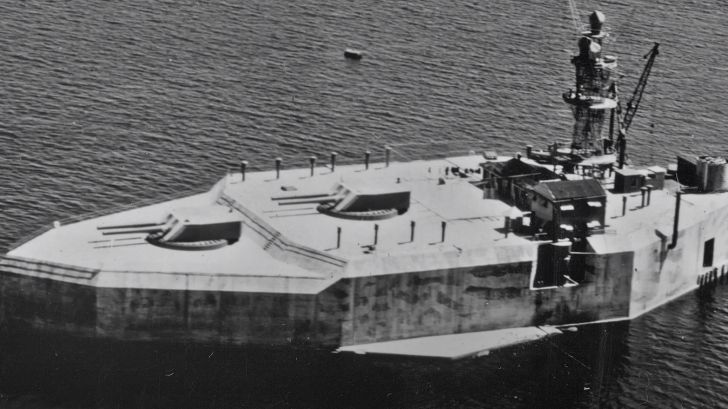1. Far From The Initial Plan
In the beginning, Fort Drum was just an island called El Fraile located at the mouth of Manila Bay in the Philippines. The small island caught the attention of US military officials, who thought it would be a great idea to make it a mine control and casemate station.
2. El Fraile Was Leveled
After much deliberation, US officials finally decided to level the island and build a concrete structure on top. The “roof” was fortified by a 20ft thick steel-reinforced concrete deck. Moreover, its walls ranged between 25 to 36ft in thickness.
3. Multi-story Turrets
Its turrets are protected with 18 inches of armor and were mounted on heavy steel barbettes which sunk beneath several levels. To rotate the turrets, soldiers would use electrically operated tracks or their hands should the electrical systems fail.
4. Guns Were Divided Into Compartments
The gun decks were located on the surface with the upper handling room beneath. This room contained motors and gears used for its mechanisms and transferred ammo from the lower compartments. Under this room is the electrical platform, and beneath that is the lower handling room, where ammunition is loaded and retrieved.
5. Its M1909s Had Names
Fort Drum’s M1909 turrets are custom-built for the island alone. These were manufactured and tested in the US before disassembling and shipping them to the island. Because of its unique construction, the US thought it would be best if they were named. Thus, Battery Marshall and Battery Wilson were born.
6. Vertically-Stacked Guns
Four 6-in M1910 guns were fitted to the port and starboard of the fort. These were vertically stacked to conserve space and increase traversal range. They were held in place by reinforced casemates made up of 6ft of reinforced concrete and 6in of armored steel plates. The two batteries were called Battery Roberts and Battery McCrea.
7. Secure During Bombings
Its thick concrete walls proved to be very effective in shielding its crew from Japanese bombing attacks. In the event of an attack, the men would take shelter in the lower levels where the dispensary was located. Only those who remained on the deck sustained injuries.
8. Immense Floor Space
3,500ft of floor space, spread out into three levels, could be found inside the fort’s walls. This was done to accommodate at least 300 enlisted men if needed. The first floor was the barracks area, complete with its own hospital. The kitchen, mess hall, and engine rooms were on the second floor. Finally, the third floor housed the laundry area, fuel, machine shop, and main engine room.
9. Named In Honor Of A US General
Though some US sailors might call Fort Drum “USS No-Go,” the fort’s name actually comes from a US Brigadier General called Richard C. Drum. Drum served with distinction during the American Civil War and the Mexican-American War.
10. Looted and Abandoned Today
The defensive fort was completely abandoned since the end of the second World War. Looters have already done their jobs back in the 70s. Still, its turrets and 14-in guns are intact today.



